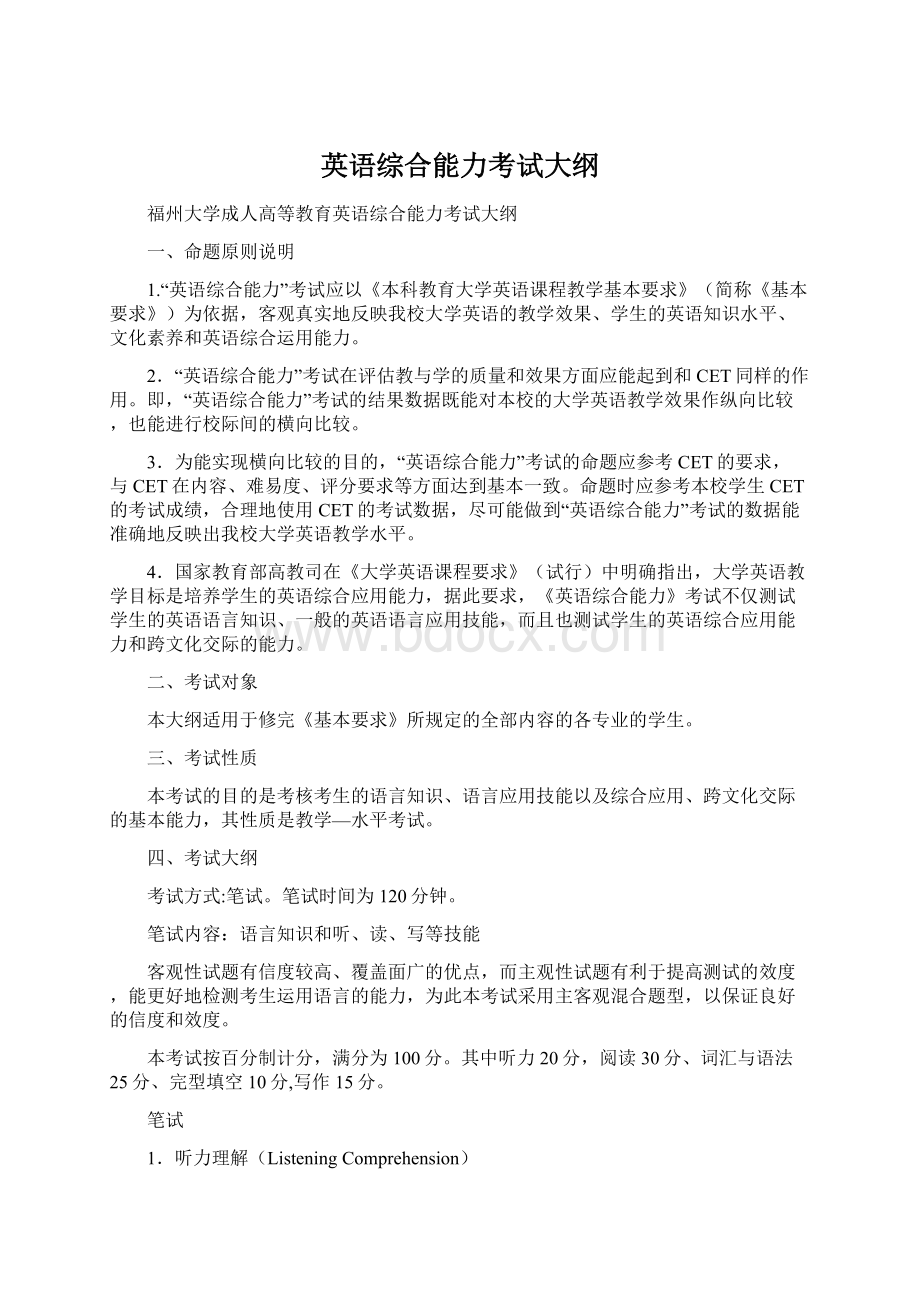英语综合能力考试大纲.docx
《英语综合能力考试大纲.docx》由会员分享,可在线阅读,更多相关《英语综合能力考试大纲.docx(16页珍藏版)》请在冰豆网上搜索。

英语综合能力考试大纲
福州大学成人高等教育英语综合能力考试大纲
一、命题原则说明
1.“英语综合能力”考试应以《本科教育大学英语课程教学基本要求》(简称《基本要求》)为依据,客观真实地反映我校大学英语的教学效果、学生的英语知识水平、文化素养和英语综合运用能力。
2.“英语综合能力”考试在评估教与学的质量和效果方面应能起到和CET同样的作用。
即,“英语综合能力”考试的结果数据既能对本校的大学英语教学效果作纵向比较,也能进行校际间的横向比较。
3.为能实现横向比较的目的,“英语综合能力”考试的命题应参考CET的要求,与CET在内容、难易度、评分要求等方面达到基本一致。
命题时应参考本校学生CET的考试成绩,合理地使用CET的考试数据,尽可能做到“英语综合能力”考试的数据能准确地反映出我校大学英语教学水平。
4.国家教育部高教司在《大学英语课程要求》(试行)中明确指出,大学英语教学目标是培养学生的英语综合应用能力,据此要求,《英语综合能力》考试不仅测试学生的英语语言知识、一般的英语语言应用技能,而且也测试学生的英语综合应用能力和跨文化交际的能力。
二、考试对象
本大纲适用于修完《基本要求》所规定的全部内容的各专业的学生。
三、考试性质
本考试的目的是考核考生的语言知识、语言应用技能以及综合应用、跨文化交际的基本能力,其性质是教学—水平考试。
四、考试大纲
考试方式:
笔试。
笔试时间为120分钟。
笔试内容:
语言知识和听、读、写等技能
客观性试题有信度较高、覆盖面广的优点,而主观性试题有利于提高测试的效度,能更好地检测考生运用语言的能力,为此本考试采用主客观混合题型,以保证良好的信度和效度。
本考试按百分制计分,满分为100分。
其中听力20分,阅读30分、词汇与语法25分、完型填空10分,写作15分。
笔试
1.听力理解(ListeningComprehension)
测试考生运用基本的听力技巧理解所听对话、会话和简单短文及复合式听写的能力。
听力材料的语速为每分钟130个词,能掌握其中心大意、抓住要点。
本部分的得分占总分的20%。
测试时间为20分钟。
2.阅读理解(ReadingComprehension)
测试考生运用有效的阅读技巧基本读懂一般性题材的英文文章,阅读速度达到每分钟70个词;在快速阅读篇幅较长、难度略低的材料时,阅读速度达到每分钟100个词;能基本读懂国内英文报刊,掌握中心意思,理解主要事实和有关细节;能读懂工作、生活中常见的应用文体的材料。
本部分的得分占总分的30%。
测试时间为35分钟。
3.词汇用法与语法结构(VocabularyandStructure)
测试考生正确运用词汇、短语和语法知识的能力。
测试范围包括《基本要求》所规定的“掌握的词汇达到4500个单词和700个词组”,其中2000个单词为积极词汇。
本部分的得分占总分的25%。
测试时间为25分钟。
4.完型填空(Cloze)
完型填空部分的目的是测试学生综合运用语言的能力,也即理解篇章和使用词汇和语法的能力。
考试采用的完型填空题是:
“在一篇题材熟悉、难度适中的短文(约200-250词)内留有20个空白,每个空白为一题,每题有四个选择项,要求考生在全面理解内容的基础上选择一个最佳答案,使短文的意识和结构恢复完整”。
本部分的得分占总分的10%。
测试时间为10分钟。
4.写作(Writing)
写作测试考生运用基本的写作技能进行一般性的写作;能写常见的应用文、说明文、描写文、议论文等;能就一般性话题或提纲在半小时内写出120个词的短文,内容基本完整,用词恰当,语意连贯。
本部分的得分占总分的15%。
测试时间为30分钟。
考试参考用书:
1.《大学英语综合能力考试模拟题》上海外语音像出版社,上海外语电子出版社 2010年11月 总主编吴松江
2.《大学英语四/六级写作训练与测试》上海外语音像出版社,上海外语电子出版社 2010年11月 总主编吴松江
福州大学外国语学院大学英语教学部
2011年3月
大学英语综合能力考试样题(笔试)和答案
ComprehensiveEnglishTestForColleges(SampleTest)
PartIListeningComprehension(20minutes,20%)
SectionA
Directions:
Inthissectionyouwillhear5shortconversations.Attheendofeachconversation,aquestionwillbeaskedaboutwhatwassaid.Theconversationandthequestionwillbereadonlyonce.Aftereachquestiontherewillbeapause.Duringthepause,youmustreadthefourchoicesmarkedA),B),C)andD),anddecidewhichisthebestanswer.ThenmarkthecorrespondingletterontheAnswerSheetwithasinglelinethroughthecenter.
Example:
Youwillhear:
Man:
What’sinthatbigbagoverthere?
Woman:
Iboughtsomeapples,peachesandgrapes.
Question:
Whatdidthewomanbuy?
Youwillread:
A)Vegetables.
B)Fruit.
C)Meat.
D)Cookies.
Accordingtothewords“apples”,“peaches”and“grapes”,thebestanswershouldbe“B)”,-“fruit”.Youshouldchoosetheletter“B”.Nowlet’sbeginSectionAwithQuestionnumber1.
1.A)Hewantstosellsomeoldbooks.
B)Hewantstobuysomeoldbookcases.
C)Hewantstovisitsomenewbookstores.
D)Hewantstobuysomenewtextbooks.
2.A)Theycouldbuytheticketssoon.
B)Theyhadtojumpthequeue.
C)Theyhadtomissthefirstpartofthemovie.
D)Theyarenotstrongenoughtopushforward.
3.A)Inspring.B)Insummer.
C)Inautumn.D)Inwinter.
4.A)Theyquarreledalotalltheway.
B)Theywerenotallowedtotalktoeachother.
C)Theymadespecialweddingvowsbythemselves.
D)Theyforgotaboutthestandardsetofspeechasrequired.
5.A)Shewaspromotedtoahigherposition.
B)Shediednotlongago.
C)Shelostalotofmoneyrecently.
D)Shehadjustcomebackfromthehospital.
SectionB
Directions:
SectionBconsistsoffivequestions,eachofwhichisbasedonadifferentmonologueorconversation.Nowyouwillhearpeopletalkingindifferentsituations.Forquestions6to10,choosethebestanswerA,B),C),orD).
6.A)Teacherandstudent.B)Bossandclerk.
C)Husbandandwife.D)Salesmanandcustomer.
7.A)Thosecustomers’complaintsarecheating.
B)Thosediscountsareforthesakeofthebusiness.
C)Shethoughttheyshouldnothavecheatedthecustomers.
D)Shethoughttheyshouldhavechargedmoreonthecustomers.
8.A)Theyarenon-achievers.
B)Theyaretoolazy.
C)Theydon’tunderstandhimwell.
D)Theyarenotresponsibleenough.
9.A)Heoverslept.
B)Hewasstuckinacharityshop.
C)Hisgirlfriendwasseriouslyill.
D)Hisfrienddidnotpickhimupaspromised.
10.A)Customersinthedepartmentstore.
B)Customersinthedrugstore.
C)Passengersintheairport.
D)Passengersonaship.
SectionC
Directions:
Inthissectionyouwillhearatalkandaconversation.Aftereachofthem,youwillhearsomequestions.Thetalksandthequestionswillbereadonlyonce.Afteryouhearaquestion,youmustchoosethebestanswerfromthefourchoicesmarkedA),B),C)andD).ThenmarkthecorrespondingletterontheAnswerSheetwithasinglelinethroughthecenter.
Questions11-15arebasedonthefollowingtalk:
11.A)InordertoteachthegirlshowtospeakEnglish.
B)Inordertogethelpwithhousework.
C)Inordertoallowthegirlstotravel.
D)Inordertogetcheapfoodandlodgings.
12.A)Becausethegirlsandthefamilymembersarenotofthesameage.
B)Becausethegirlsaren’tgivenproperfood.
C)Becausethegirlsareirresponsible.
D)Becausetheirinterestsclash.
13.A)Mostofthemaredissatisfied.
B)Mostofthemareveryhappy.
C)Mostofthemareunhappy.
D)Mostofthemaremoreorlesssatisfied.
14.A)Thegirlscannotjoinclubsandlanguageschools.
B)ThegirlshavefewopportunitiestomeetyoungEnglishpeople.
C)Thegirlsarenotpaidenoughfortheirlabor.
D)ThegirlsarenotinterestedinlearningEnglish.
15.A)ItcreatesalotofjobopportunitiesforBritain.
B)Itwasstartedasameanstopromotinginternationaltrade.
C)Itissuccessfulasfaraslanguagelearningisconcerned.
D)IthasbroughtgreatbenefitstolanguageschoolsinBritain.
Questions16-20arebasedonthefollowingconversation:
16.A)Theywereplayinginthestreet.
B)Theywerewatchingaballgame.
C)Theywererunninginthestreet.
D)Theywereontheirwaytoschool.
17.A)AVolkswagenandabus.
B)AtruckandaVolkswagen.
C)Twobuses.
D)Atruckandabus.
18.A)Awomansittingnearthebus.
B)Awomanstandingnearthebusstop.
C)Awomansittingnearthebusstop.
D)Amanstandingnearthebus.
19.A)Parentsofthosechildren.
B)Oneofthechildren.
C)Oneofthedrivers.
D)Bothdrivers.
20.A)Sheseemstoagreewiththewitnesscompletely.
B)Sheseemstodisagreewiththewitness.
C)Shebelievesitisnotrelevanttothisaccident.
D)Shedoesn’treacttoitatall.
PartIIReadingComprehension(35minutes,30%)
Directions:
Readthefollowingpassagesandchoosethebestanswertoeachofthequestionsfollowingthepassage.
Questions21to25arebasedonthefollowingpassage:
Whydostudentscutclassessofrequently?
Icancitetheimmediatecauses,butIfirstwanttonotethattheycancutbecausetheyareallowedto.Theycutbecauseoftheclimateofacceptancethatcomesfromourbeliefthatresponsibilitycanbedevelopedonlywhenoneisfree,freeeventoactagainstpersonalbestinterests.Thatthatisamisappliedbeliefinthiscasecanbeeasilydemonstrated.Whensubstantialnumbersofstudentsdonotattend,classroomlearningisdepreciated(贬低),studentandteachermoralesuffers,andacademicstandardsarecompromised.Studentswhomissclassesunnecessarilyarehurtingmorethanthemselves.Theyareunderminingwhatcollegesanduniversitiesareallabout.
Studentscutfortwogeneralreasons.Theyhavethingstodothatappearmoreimportantthantheclass,ortheywishtoavoidwhattheyfearwillbepainfulconsequencesiftheyattend.Inregardtothefirst,nursinganillnessorattendingfamilyweddingsaregoodexcusesformissingaclass.Butotherexcuses—thedemandsofoutsidejobs,socialengagements(includingrecoveringfromthenightbefore),completingassignmentsforothercourses—are,atbest,questionable.
Theothergeneralreasonismoredisturbingandperhapslesswellrecognized.Afewyearsago,Iaskedseveralclasseswhattheymostdislikedaboutthewaycoursesweretaught,andtheanswerwasplain—anythingthatproducedsustainedtensionoranxiety.Ibelievecuttingisoftenaresultofthataversion.Theresponseofstudentstofeelingsofpersonalinadequacy,fearofhumiliation,orathreateningprofessorialpersonalityorteachingstyleisoftensimplytoavoidclass.Thisresponsefeedsonitself,asfrequentabsencesmakeattendingevenmorethreatening.
Butwhataccountsforfrequentcuttingwheretheteachertriestomakethematerialinteresting,knowsthestudentsbyname,andapproachesthemwithrespectandhelp?
Iacceptthatquestionsasunanswerable.Isimplytellmystudents:
Attendmyclassesregularlyordropthecourse.That’stherule.
21.Theword“that”(Line4,Para.1)refersto__________.
A)theimmediatecausesofthestudents’absencefromclasses
B)theauthor’sbeliefthatstudentsarepermittedtocutclasses
C)teachers’toleranceofthestudentswhorarelyshowupintheclassroom
D)thebeliefthatfreedomisessentialincultivatingasenseofresponsibility
22.Whydouniversitystudentssooftenmissclasses?
A)Theyareadvisedtorestuntiltheyrecoverfromtheirillnesses.
B)Theywanttoavoidpainfulfeelingsbroughtbytheprofessors.
C)Theinadequateallowancestheygetforcethemtotakepart-timejobs.
D)Theythinktheteachingqualificationsoftheprofessorsareopentoquestion.
23.Theword“aversion”(Line4,Para.3)means__________.
A)responseB)dislike
C)excuseD)plainness
24.Whatistheresultofthestudents’frequentcutting?
A)Theyarelikelytoavoidmoreclasses.
B)Theyhavetolowertheiracademicstandards.
C)Theyareinvolvedinmoresocialactiv